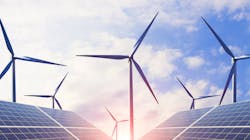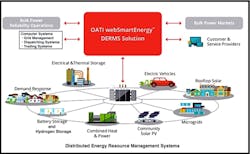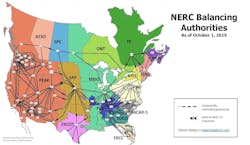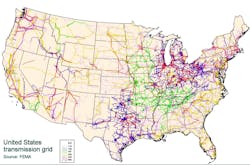A Practical Pathway for Our National Renewable Energy Future: Part 2
Reducing carbon output from the American power grid is an essential goal, meriting urgent and committed attention. However, while accelerating the growth of low-carbon technology on the current U.S. grid for decarbonization is laudable (suggesting that all changes could be made within 10 years), it is currently impractical and enormously risky. Part 1 of this four-part series introduced the grid at the edge, how it works, and dealing with risks. Part 2 discusses how to achieve a low-carbon renewable energy power system on the new grid and the dangers of a 10-year timeline.
How to Achieve Low-Carbon Renewable Energy Power System Using New Grid
Achieving the energy goals of a low-carbon renewable energy power system program requires a paradigm shift in the power generation, transmission and distribution (T&D) of America's energy system. This paradigm shift entails augmenting and/or partially replacing the current power system with different methods of producing, transmitting, and delivering energy. Creating a generation system dominated by renewable energy requires significant modifications and additions to current T&D systems. This new generation mix and geographic redistribution needs a new grid approach for interconnection and operation.
The current Green New Deal (GND) energy proposal eliminates carbon dioxide (CO2) output by removing all fossil energy generation and decommissioning all nuclear-based power. These endeavors mandate developing and implementing the new grid. The technology to generate renewable energy on both small and large scales exists today. Regardless of the final mix of new and existing generation, the effort to successfully accomplish the foregoing tasks in 10 years creates insurmountable challenges, including dangerous operational circumstances. The National Academy of Science (USA) EIA projects that the share of total U.S. electricity generation produced by all renewables other than hydropower will increase by three percentage points during the next two years, from 10% of total generation in 2018 to 13% in 2020.
Alternatively, a modified green proposal could contain nonrenewable energy sources including high-efficiency low-carbon fossil generation supplemented with carbon capture and storage capabilities. A modified green proposal would also require gradually replacing existing nuclear power plants with the advanced small modular reactors (SMR). Such additions would provide the backbone of highly controllable power sources, which would handle the primary task of safe and stable grid power flow. To be effective, this power configuration would require the new grid.
I believe that an objective analysis of the energy and climate interrelationships will reveal that retaining and/or adding to generation, employing new large cleaner fossil and small nuclear reactors is environmentally, technically, and financially prudent. Retaining a prudent selection of fossil and nuclear generation would also simplify and accelerate the implementation of the renewable energy resources and would require implementing the new grid.
Implementing the new grid in concert with electric transportation and smart energy conservation programs (LEED) would also facilitate expansion and control of the reduced carbon and carbon-free energy generation. Additionally, implementing the new grid would provide an opportunity to integrate the value of analyzing vast amounts of data, leveraging the usefulness of so-called big data using artificial intelligence (AI), and using the internet of things (IoT) to optimize monitoring, control, and protection of the New Grid. These concepts are also within the realm of technical possibilities and would form the heart of the new computer systems required for the new grid to function successfully. The DERMS diagram illustrated below shows the OATI concept for managing the new grid.
How Present System Works
Fig. 1 is a simplistic map representing power balancing authorities of the North American Regional Reliability Councils, now commonly known as NERC.
Fig. 1 represents the regional control schema for managing power flow over the transmission lines within the regional areas of control. NERC promotes a reliable and ample supply of bulk power transmission to the electric energy systems of North America. Intricate webs of power transmission lines ranging in voltage up to 765 kV comprise the subject regions. These transmission lines cover North America and this network overlays many more sub-transmission power lines. Beneath that system, an extraordinarily large number of distribution substations are connected to individual consumers.
A successful technical solution for reducing carbon because of energy production requires redefining the complicated interrelationships existing between power generation and delivery and the consumers of energy. For example, there are many hundreds of critical power flow interconnections that must exchange power in a safe and reliable manner. Careful management and protection of these interconnections require real-time oversight. See Fig. 2.
In order to function reliably, energy (regardless of its fuel source) must flow over thousands of miles of interconnecting power conduits. Sophisticated computer systems carefully monitor and control the interconnections to maintain proper levels of power flow, voltage, frequency, and power factor.
Additionally, monitoring and control systems allow commercial trading markets to deliver purchased power and set pricing, and calculate billing for buyers and sellers of that power. To satisfy commercial energy transfer contracts, trading systems coordinate with load dispatching systems to apportion the intended power system load flow. Real-time load apportionments are made by selecting which generating units to start, stop, or change output. To satisfy the requirements, the choice of which unit to adjust considers unit geographical location and the unit's thermodynamic and financial performance. Many of the existing generating units have controllable output levels, so that central dispatching centers can easily vary unit output. Secure controllability is a key success element of the old paradigm. Refer to NERC: The Key to North America's Electrical Infrastructure.
Challenges in Realizing Objectives of New Grid
Replacing electric energy production of reliable and controllable power plants with that generated from some intermittently available renewable resources leads to loss of the capability to safely and efficiently control the grid — we also need to replace the ancillary services that those controllable power plants provide. On top of this list is a service that is known as operating reserves. Since production and demand must match so perfectly (see scheduling and dispatch), operating reserves help make up the difference when production is too low.
- Operating reserve is an adjustable generator power capability that can quickly be dispatched to ensure that there is sufficient energy generation to meet load. Spinning reserves are generator capabilities that are already online and can rapidly change their power output to meet fast changes in demand. Spinning reserves are required because demand can vary on short timescales and rapid response is needed to insure stability. Supplemental reserves are generators that can be dispatched by the operator to meet demand but cannot respond as quickly as spinning reserves.
- The above-mentioned services within a region of an interconnection becomes vital when the region loses one or more of its large electric power production resources and/or its tie-lines to neighboring power systems. This service is currently delivered by some standby resources that can quickly produce and/or increase their production of electric power with a short notice within the impacted region to mitigate overloading its remaining tie-lines. Inability to maintain dependable standby electric power production resources can interrupt electricity supply to a large number of electric power consumers.
- Standby electric power production resources are currently provided mostly by the extra band of fossil-fired steam and/or combined cycle power plants as well as gas turbines, hydro dams, and pump storage systems. Some utilities are evaluating the extent to which they should invest in storage systems like batteries, controllable renewable resources like hydrogen, and renewable natural gas.
- Penetration of intermittent resources like wind and solar will demand a level of operating reserves many times that of the current level.
"Each of these cautions create greater risks when considered over a shorter period of time," said Nasser Jaleeli, CEO and co-founder, Priority-based Control Engineering, and former consulting engineer in American Electric Power's engineering computer application division. "Given the magnitude of these improvements, 10 years is indeed a very short implementation period. Consequently, the risks become unacceptable."
Parts 3 and 4 of this four-part series will discuss the transition to DERs (old paradigm to new paradigm), hydrogen fuel as a disruptor, and power from hydrogen as a fuel of the future.
Technical Acknowledgements
The author would like to thank the following colleagues for offering encouragement, comments, and review of this series. Their help was technical and editorial in nature and does not imply their endorsement of the concepts that the author describes. The views and opinions included within the article are those of the author and may not reflect those of the editors or any other person or entity that contributed to this article.
- John Gentile – Director of Cascadia Energy Technologies, LLC
- Daniel Udovic, PhD-EE, PE – CEO of Processor Innovations
- Dan Madden, PE – CEO of Eco Energy International
- Nasser Jaleeli, PhD-EE, PE – CEO of Priority-based Control Engineering
- Michael Heyeck, PE – Founder, The Grid Group, LLC
- Tim Lowe, PhD – VP of Eco Energy International
- Harry MacCormack, MFA – Board member of Ten Rivers Food Web
- Bernie Gagliano – Independent consultant and information architect
About the Author
Thomas A. McClimans
Thomas A. McClimans, P. E. is a director of Cascadia Energy Technology in Corvallis, Oregon. He has been enjoying a more than 45-year career in power generation (O&M), power plant construction, and computer control systems. Early in his career, McClimans implemented a groundbreaking direct digital control (DDC) system at an 800-MW coal-fired, super-critical generating unit at the Conesville Power Plant. He later became the youngest plant manager at Conesville, which was a 2000-MW generating station with over 600 employees and an annual budget in excess of US$150 million.
Since then, he has held senior level management and engineering positions in both domestic and international markets, working for such firms as American Electric Power (AEP), Black & Veatch International (BVI), NRG and TECO Power Services. Project responsibilities include EPC management, IT project management, O&M management, and generation portfolio management.
His assignments include some of the most challenging electric generating projects in the world. For example, as director of engineering computer applications for the AEP, he directed developing and implementing the computer control system for the AEP transmission grid and also implemented enterprise asset management systems for the AEP's fossil and nuclear generating plants.
Working as general manager for the BVI, he directed a generation optimization project for the 5000-MW Saudi Consolidated Electricity Co. in Jeddah, Saudi Arabia. Also working for the BVI, McClimans successfully directed redesigning and optimizing a waste-to-energy power plant in the United Kingdom and then managed several EPC projects in Thailand. Working as task manager for BVI-USAID, McClimans managed a project to help restore generation in Afghanistan. Working as general manager for NRG and TECO Power Services, he managed a multistate merchant power plant portfolio based on coal-fired boilers and gas-fired CCTs.
McClimans earned a BSc in electrical engineering from Ohio University. He is a registered professional engineer in Ohio and a life member of Institute of Electrical and Electronics Engineers (IEEE).



